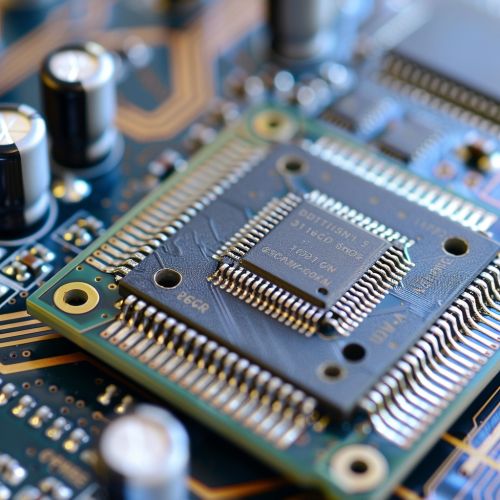Digital Signal Processor
Introduction
A Digital Signal Processor (DSP) is a specialized microprocessor designed specifically for the manipulation of digital signals in real-time. Unlike general-purpose microprocessors, DSPs are optimized for high-speed numeric processing, making them essential in applications requiring fast and efficient data processing. These applications span across various fields such as telecommunications, audio processing, radar, and biomedical engineering.
Architecture
The architecture of a DSP is tailored to perform complex mathematical operations quickly and efficiently. Key architectural features include:
Harvard Architecture
DSPs typically use the Harvard architecture, which separates the memory used for instructions and data. This allows simultaneous access to both instruction and data memories, significantly speeding up processing.
Multiply-Accumulate (MAC) Unit
A critical component of DSPs is the Multiply-Accumulate (MAC) unit, which performs multiplication and addition in a single operation. This is essential for algorithms like FFT and FIR filtering.
Specialized Instruction Set
DSPs have a specialized instruction set optimized for signal processing tasks. These instructions include operations like circular buffering, bit-reversed addressing, and saturation arithmetic, which are not typically found in general-purpose processors.
Pipelining
To enhance performance, DSPs employ pipelining, a technique that allows multiple instruction phases to be processed simultaneously. This reduces the time taken to execute instructions and increases overall throughput.


Applications
DSPs are integral to a wide range of applications, each leveraging the processor's ability to handle real-time data efficiently.
Telecommunications
In telecommunications, DSPs are used for modulation, demodulation, echo cancellation, and data compression. They enable high-speed data transmission and improve the quality of voice and video communications.
Audio Processing
DSPs play a crucial role in audio processing, including digital audio effects, noise reduction, and audio compression. They are used in devices like hearing aids, smartphones, and home theater systems to enhance sound quality.
Radar and Sonar
In radar and sonar systems, DSPs process the reflected signals to detect and identify objects. They perform tasks such as signal filtering, pulse compression, and target tracking.
Biomedical Engineering
In biomedical engineering, DSPs are used in medical imaging, ECG analysis, and ultrasound processing. They help in diagnosing medical conditions by processing complex biological signals.
Algorithms
DSPs execute a variety of algorithms that are fundamental to signal processing.
Fast Fourier Transform (FFT)
The FFT is an algorithm that computes the discrete Fourier transform (DFT) and its inverse. It is widely used in applications like spectrum analysis, image reconstruction, and signal modulation.
Finite Impulse Response (FIR) Filters
FIR filters are used to filter signals in a way that the output depends only on the current and past input values. They are characterized by their stability and linear phase response.
Infinite Impulse Response (IIR) Filters
IIR filters use feedback to create an output that depends on both current and past inputs and outputs. They are more efficient than FIR filters but can be less stable.
Adaptive Filters
Adaptive filters adjust their parameters in real-time to adapt to changing signal characteristics. They are used in applications like echo cancellation and noise reduction.
Development Tools
Developing applications for DSPs requires specialized tools and environments.
Integrated Development Environments (IDEs)
DSP manufacturers provide IDEs that include compilers, debuggers, and simulators. These tools help developers write, test, and optimize their code.
Libraries and Frameworks
There are numerous libraries and frameworks available for DSP development, offering pre-written code for common algorithms and functions. Examples include Texas Instruments' DSP libraries and Analog Devices' VisualDSP++.
Real-Time Operating Systems (RTOS)
Many DSP applications require real-time processing, which is facilitated by RTOS. These operating systems manage the processor's resources to ensure timely execution of tasks.
Future Trends
The field of digital signal processing is continually evolving, with several emerging trends shaping its future.
Machine Learning and AI
The integration of machine learning and AI with DSPs is opening new possibilities in areas like speech recognition, image processing, and predictive maintenance.
Internet of Things (IoT)
DSPs are becoming increasingly important in the IoT ecosystem, where they process data from various sensors and devices in real-time to enable smart applications.
5G and Beyond
With the advent of 5G technology, DSPs are crucial in managing the increased data rates and complex signal processing requirements. Future wireless communication systems will rely heavily on advanced DSP techniques.
